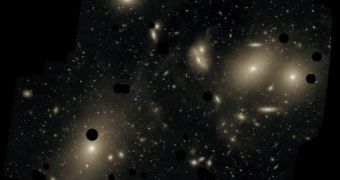Astronomers working with the Very Large Telescope (VLT), operated in Chile by the European Southern Observatory (ESO), finally managed to infer the real size of the giant elliptical galaxy Messier 87, also known as M87, Virgo A or NGC 4486. According to the recent investigation, it would appear that some of the galaxy's outermost layers were virtually ripped apart by yet unidentified forces, and also that the giant formation is currently on a collision course with another member of the Virgo galaxy cluster, located some 55 million light-years away from Earth.
The visible size of M87, which now spans about 120,000 light-years, has been cut short, the astronomers say, although, at this point, they have no idea as to what force may have caused this to happen. “This is an unexpected result. Numerical models predict that the halo around Messier 87 should be several times larger than our observations have revealed. Clearly, something must have cut the halo off early on,” the co-author of the new study, Astronomer Ortwin Gerhard, explains. Still, he adds, the halo surrounding Virgo A is about three times more massive than that around the Milky Way.
Using VLT's super-efficient spectrograph FLAMES, the team at the Paranal Observatory in Chile succeeded in taking snapshots of the sky over a portion roughly equivalent to the size of the Moon. FLAMES was uniquely equipped for this job, on account of the fact that the instrument can take spectrum measurements from multiple sources in the sky. “It is a little bit like looking for a needle in a haystack, but in the dark. The FLAMES spectrograph on the VLT was the best instrument for the job,” Magda Arnaboldi, one of the members of the team that worked on the new find, adds.
The collapse of massive amounts of dark matter around the cluster may be one of the reasons why the galaxy's halo was cut off short, the astronomers hypothesize. Another explanation could be that one of the formation's neighbors, Messier 85, came very close to Virgo A some one billion years ago, severely perturbing its formation and development processes. “At this stage, we can’t confirm any of these scenarios. We will need observations of many more planetary nebulae around Messier 87,” Arnaboldi concludes.

 14 DAY TRIAL //
14 DAY TRIAL //